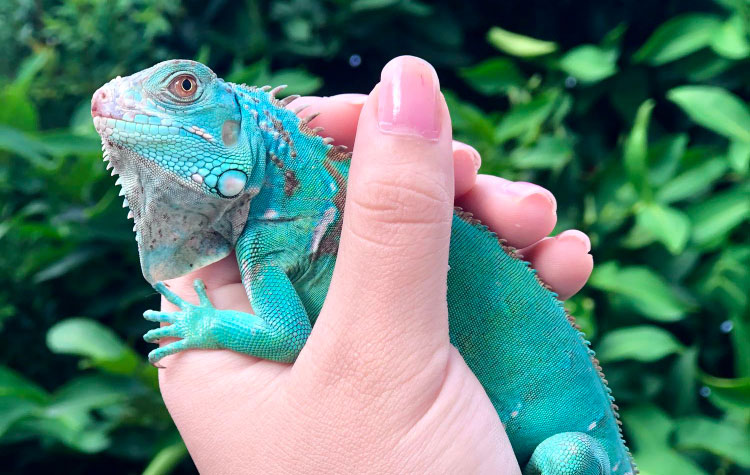The first thing you have to remember before you tame your iguana is, “do not rush!” Making a good bond with your pet iguana takes time and certain stages. Learn how to tame your iguana by following these tips:
So, how to make your iguana like you? At the very beginning, here are some takeaways from the relatively long article:
♣ Buy Young Iguanas / Baby: Although taming adult iguana is not impossible it’s highly recommended to keep it since baby stage. It will bond with you easier.
♣ Prepare a comfortable place for your iguana: It will not be happy when the place is uncomfortable and feels hostile.
♣ Know the nature and gestures of your pet: Iguana will show a typical movement when it feels threatened, its head goes upright with eyes looking towards you or by moving his tail.
♣ Talk to it: you should talk to it. The more your iguana recognizes your voice, the more it will feel comfortable when you begin to interact intensively with it.
♣ Touch it: start stretching your hand slowly toward the iguana as often as possible, gently stroke them, hand feed, lift from the side, and do not hold them without gloves.
Read on more about how to make your iguana happy.
First, let me say that this guide was mainly created for training baby iguanas. Though it’s certainly possible that you can tame an adult iguana from scratch, the best way to go about it is to start while your iguana’s still an infant.
By now you should have a cage ready for your pet, when he or she gets home (I will usually refer the iguana as ‘he’ for the sake of simplicity, without any disrespect for female members of this species). The habitat should be as close to iguana’s natural environment as possible, which means there should be live plants and thick branches for protection and for making your pet feel right at home and have a place to hide when needed.
Place the cage in a lounge area where your iguana can see the TV and experience less human traffic throughout the day. It’s a wise move to cover up the 3 sides of the habitat (back and sides) so your pet won’t have to keep an eye out for possible intruders all the time.
During the first 2 weeks of habitation you should leave your iguana alone.
This should give him enough time to acclimate, settle in and observe you doing normal things such as watching TV, moving about, etc. without making contact. After that, it’s time to make contact with your new pet. Taming your iguana won’t happen instantly, and you should expect some bumps along the way. Even with your best efforts, be ready to wait up to three months before you can be fully satisfied with results, so, don’t give up.
Your baby iguana may whip its tail, start bolting about or even try to bite you when you get too close.
This behavior is completely normal. To your iguana, you appear as huge, capable predator that has cornered his prey and it could mean the end of your pet’s life. It’s natural instinct for your iguana’s brain to go “run, hide, do something quick!” when there’s someone bigger than he is approaching with unknown intentions. And if they’re in a cage and can’t get out, flight could turn quickly into fight.
Keep in mind that an alien touch for an untamed iguana is deathly terrifying so it’s best to do it right.
Don’t chase your iguana around the cage every time you open the door to prevent unnecessary stress; your iguana will remember the last encounter and instinctively run like mad no matter what you do. Iguanas have great memory!
Here’s what you can do to tame your pet iguana. Several times in the span of a few days, open the cage and tentatively hang at the entrance and offer him food. Your baby iguana will most likely refuse the offer at first, which is fine. The trick here is to get him acclimated to your hand and your presence. Your iguana will then realize that you’re not planning on doing any harm and will come forward to take the food. Once he does, then very, very slowly move up your hand and try to stroke your iguana. If he bolts down to the far end, then simply repeat the process until your iguana gets comfortable with the routine and finally allows you to touch him.
Your hands must mean a good thing to your baby iguana. It could be a treat, a toy or anything that your iguana thinks of as safe and good. It’d be nice if you were to start with showing only one hand during this time and keep the other hand hidden behind your back.
Now, what if you want to take your iguana out of the cage and into the open?
Rule number 1:
Pick up your iguana only after you’re well used to hand feeding and stroking him without the urge (your urge) to run away!
The main obstacle in holding an iguana is – fear. Both iguana’s and owner’s. So, before even thinking about holding your pet, make sure that at least one of these two sides involved is not scared to death.
If you do afraid, it’s perfectly understandable, you’d be glad to know that there are reptile handling gloves available on the market, so that you can minimize the risk of being scratched (or ‘tagged’ as some iguana owners benevolently say).
‘Minor’ scratches and bites are not uncommon.
Ok, enough of preparation, let’s proceed to the fun part. Ready?
The plan is theoretically simple:
- open the habitat door,
- take your pet
- move him out of the cage.
Everything should be done quickly, without hesitation and without eye contact. The key here is to get your iguana out quickly that he or she won’t have time to think or react.
Iguanas, in general, prefer to bask somewhere high up in the trees. Their predators most often come from above and snatch them up before taking off to the skies.
Tip: when you purchase (or make) a cage, avoid ones where you can approach your pet only from above. That makes them uncomfortable, at best.
Your iguana is programmed to expect the danger from above and for this reason it’s best to grab them from below.

Here’s how you can make a successful capture- slide your hands underneath your iguana’s breastbone area, your palm should be turned upwards and your thumb is on the same direction as your pet’s head. Begin the lift as soon as you have him securely in your grasp. 9 times out of 10 your iguana will be totally surprised and will be unable to do anything.
For juveniles you can use one hand. For larger iguanas you should use both hands- one for scooping underneath your iguana’s breastbone and the other to support the other end (from the pelvic area to the fleshy upper tail – do not hold him further down the tail since it can break).
 Image above shows how to hold an iguana with one hand. This is a comfortable position for your reptile since it simulates the natural position that wild iguana takes on the branch, so you better learn it.
Image above shows how to hold an iguana with one hand. This is a comfortable position for your reptile since it simulates the natural position that wild iguana takes on the branch, so you better learn it.
Your iguana’s survival instinct may kick in and he, or she, may grab hold of something from your cage, i.e., a branch or the cage door. Don’t jerk your pet away from that hold – he can break a nail that way; instead, gently pry off the claws and unhook the foot before continuing with the process.
Your iguana may also start wriggling vigorously in an effort to get out of your hands. With firm hands, start talking to your pet in a gentle, soothing voice the same way you’d speak to a newborn baby. And, as with a newborn baby, it’s a bad idea to drop iguana to the floor (happens when the owner is scared as well, see the Rule number 1 above).
When you pick the iguana up, do it quickly. When doing everything else, do it slowly.
Start walking to where you need to go as you do this. When your pet stops wriggling then it’s a safe bet that you can relax your hold as well. If your iguana doesn’t stop and starts getting out of your hands, then turn them towards a wall so they can ‘climb’ (not literally – you’re still holding him!) and catch their breath.
Keep in mind not to set your baby iguana down if they’re wriggling too much or else your iguana starts to think he can get away if he doesn’t stop wriggling.

Refrain from holding iguana on your head unless you are an experienced user (photo taken from http://shandiddles.blogspot.rs/ )
Newer reward bad behavior – it’s up to you to tame your iguana, not otherwise. In this case that means – let the iguana leave your hands only after it calmed down, never when it’s wriggling.
Another example, don’t overdo hand feeding – some iguanas will refuse to eat unless you hand feed them every time, and nobody has the time for that!
Iguanas can be very manipulative creatures! That’s the part of their charm.
Practice in a small room and place your iguana on your lap whenever he or she is completely relaxed. Allow for a bit of exploration but remember to put him on your lap so he can associate it with safety and relaxation.
Do start off slowly, softly and deliberately. Don’t move too quickly (be quick only when catching them), do sudden or jerky movements as to not set off their natural instincts. You can call out your pet’s name and have him or her remember it during this time. Your iguana will stare at you for a long time; this is when the bonding begins. Your iguana may try to taste you but that’s completely fine. It’s a sign of trust and a beautiful friendship.
Don’t forget to do this routine constantly. Your pet will become used to it quickly and it will become part of his life. Once that happens then the taming will be complete. Set a date and a time for it and follow through, for example, once in the morning and two times in the afternoon (5AM and 7AM is ok). Remember to be consistent, go slow and be patient!


